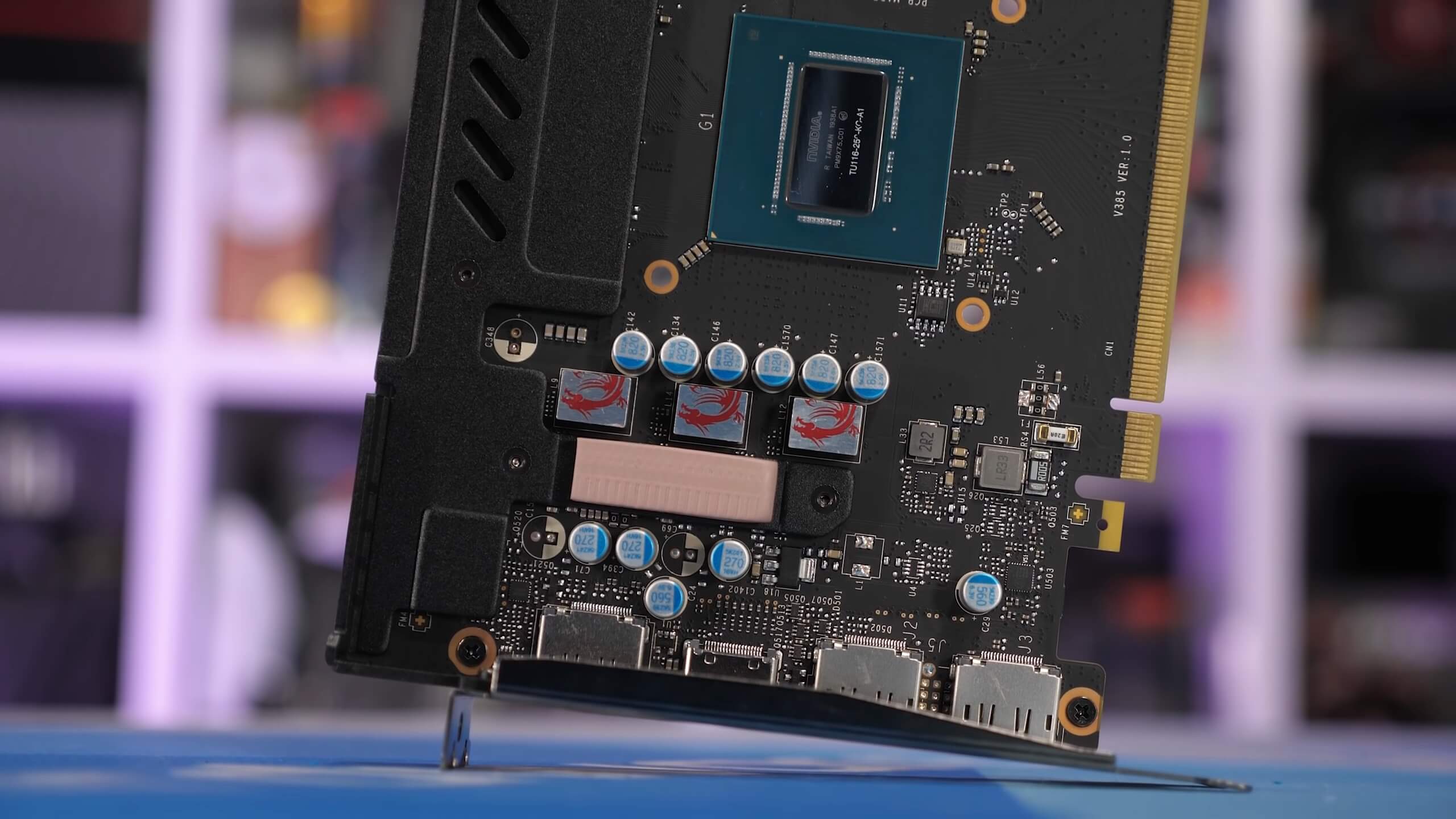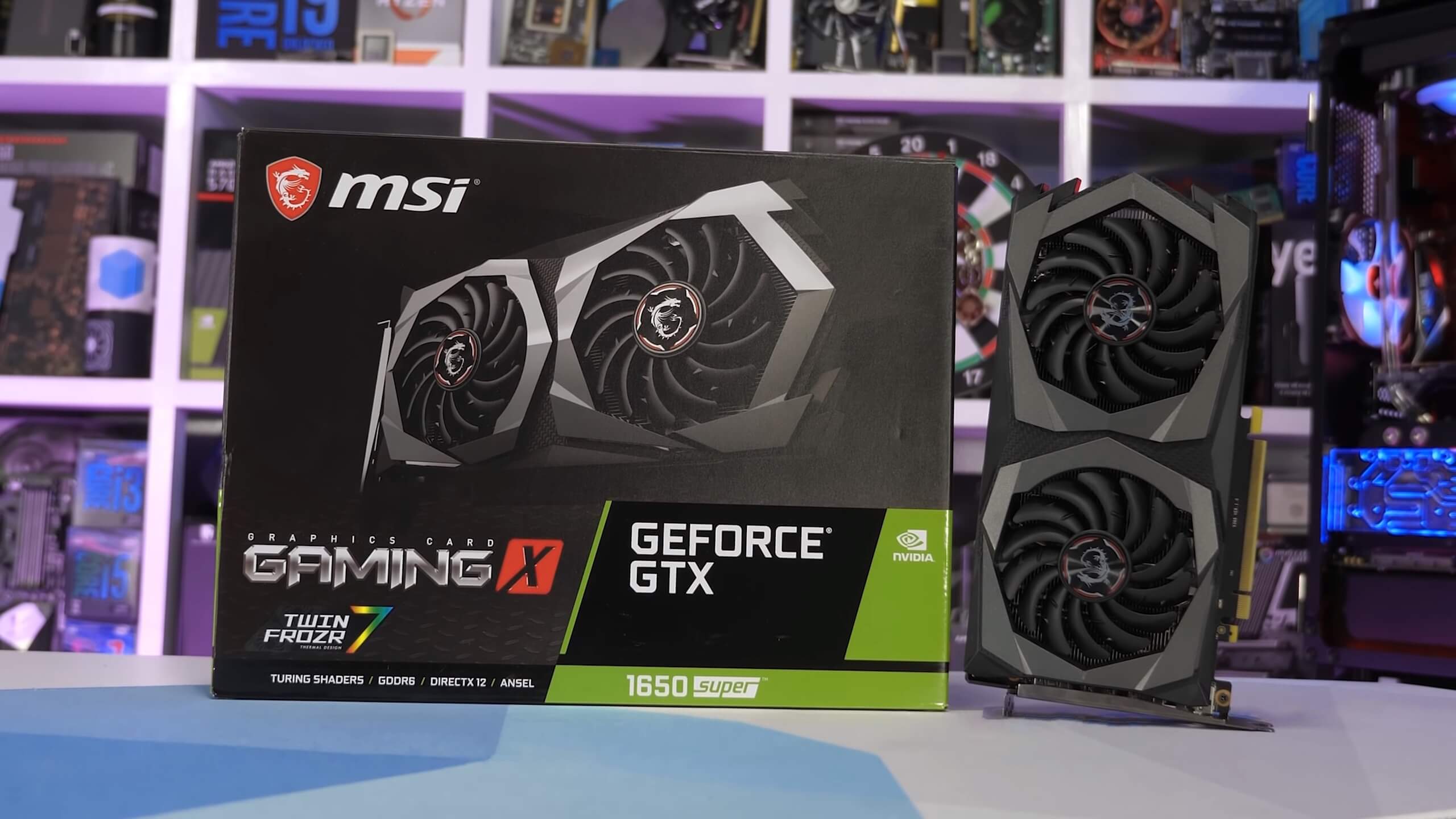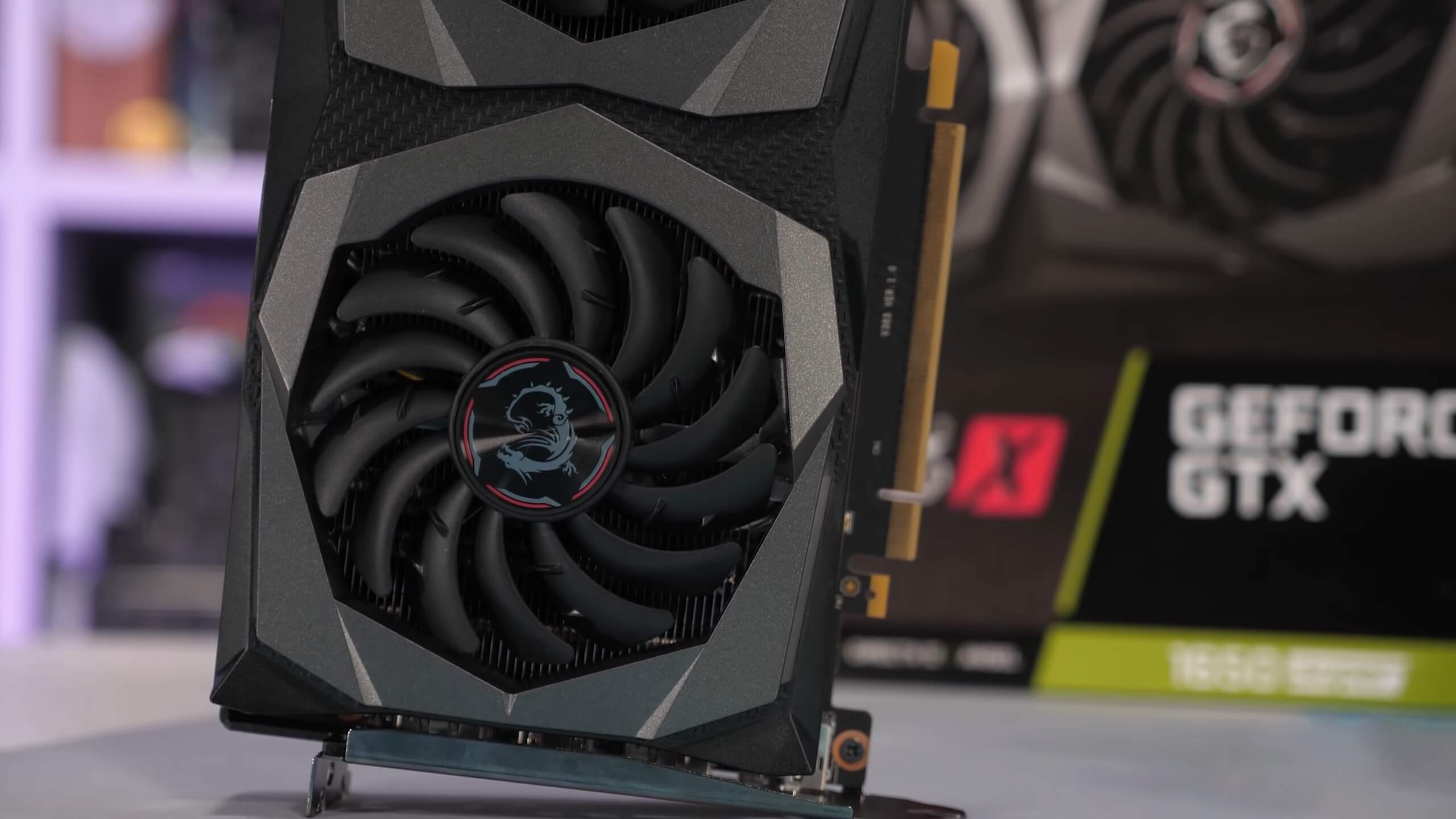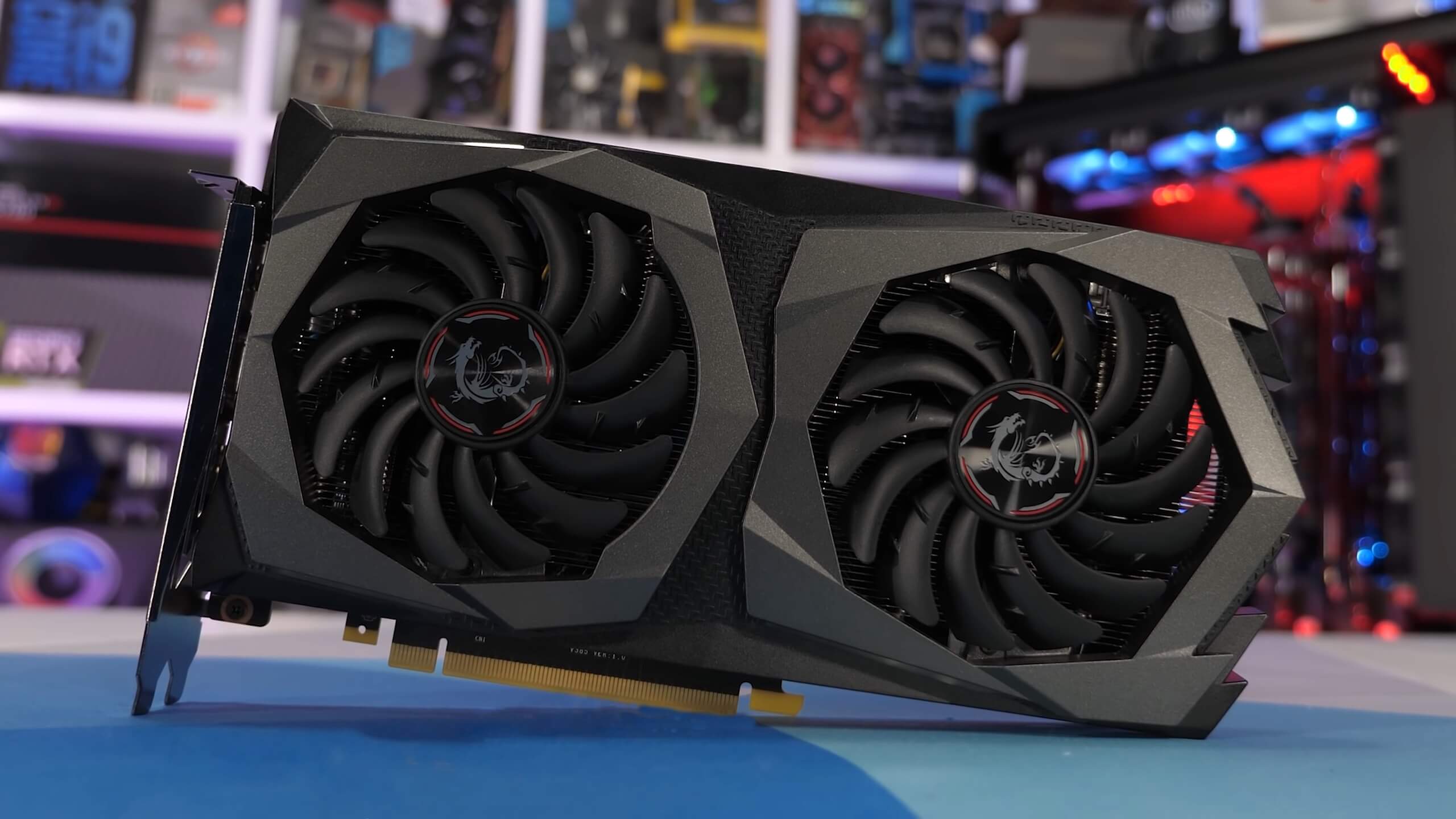Today we're bringing you a day-one review of the new GeForce GTX 1650 Super and it seems we're doing so against Nvidia's wishes. In a puzzling decision, they decided to block reviewers from having drivers ahead of release, nor did they disclose pricing. It's not the first time Nvidia pulls this kind of tactic, last time it was with the original GTX 1650 in April, which scored 60 out 100, not good. On the other hand, we're finding the GTX 1650 Super to be worth your money, so read on.
Rather than waiting for Nvidia's word on drivers we've used the 441.20 WHQL driver and with a little tinkering we were able to adapt it to the 1650 Super. The final release won't be any different, it will just have the correct information to identify and install with the 1650 Super. Even though we're not using the official driver, we're confident the performance that you'll see here is accurate.
Let's talk about the GTX 1650 Super...
The refreshed GPU packs 1280 CUDA cores, 80 texture units and 32 ROPs. It comes clocked at 1530 MHz for the base with a boost clock of 1725 MHz, though this will vary depending on the brand and model a bit. On board we have 12Gbps GDDR6 memory, though there's only 4GB of it using a 128-bit wide memory bus providing 192 GB/s of memory bandwidth.
The GTX 1650 Super is based on the TU116 die, the full part number is TU116-250, and this is the same physical die used by the GTX 1660, 1660 Super and 1660 Ti, but of course, parts of the die are deactivated. Whereas the parts we just mentioned all have 48 ROPs enabled and get the full 192-bit wide memory bus, with just 32 ROPs the 1650 Super is limited to a 128-bit memory bus.
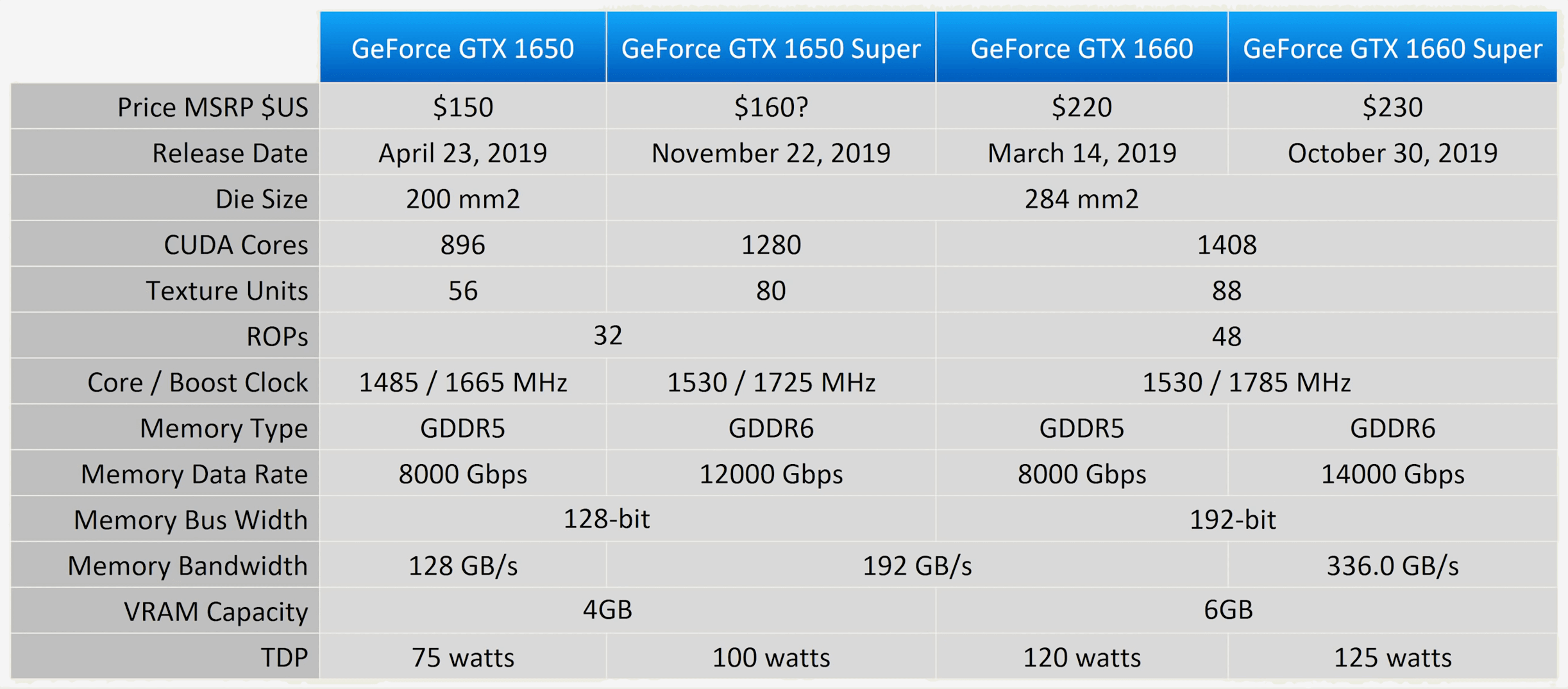
This means when compared to the base model 1650, the new Super version packs 43% more cores and texture units, but the same number of ROPs. The Super still enjoys 50% more memory bandwidth as it receives 12Gbps GDDR6 memory whereas the original 1650 comes with 4GB of 8Gbps GDDR5 memory. In short, the 1650 Super upgrades include 43% more cores and 50% more bandwidth, seems like a great deal for what should be a ~7% price increase, but we'll discuss pricing towards the end of the article.
For testing we have the MSI GTX 1650 Super Gaming X graphics card. It looks good, but it's also pretty basic, in line with what you'd expect in this price range. Out of the box the GPU peaked at just 62 degrees in a 21 C room, and better yet, the fans were spinning at just 1000 RPM, making the Gaming X virtually silent. Under these conditions the GPU averaged a clock speed of 1870 MHz.
Overclocking the Gaming X manually boosts the operating frequency to 2030 MHz, while we were able to boost the memory transfer rate from 12 Gbps to 14.5 Gbps, a ~9% boost for the core clock and 21% for the memory. This also increased the operating temperature by a single degree and raised the fan speed by 150 RPM, so the card remained cool and quiet.
Our test system is the same we use for most GPU reviews, a Core i9-9900K clocked at 5 GHz with 16GB of DDR4-3400 memory. We have 17 games to look at, all have tested at 1080p, so let's get into the results.
Benchmarks
First up we have Shadow of the Tomb Raider and here the 1650 Super averaged 60 fps, placing it on par with the RX 580 and ahead of the GTX 1060. This also made it 30% faster than the vanilla 1650. That's a huge performance boost and it means you won't need to lower quality settings in this title.

Moving on to Just Cause 4 we see the new 1650 Super delivers 35% more frames than the original version, placing it between the RX 580 and 590. It also means it was just 5% slower than the GTX 1660.
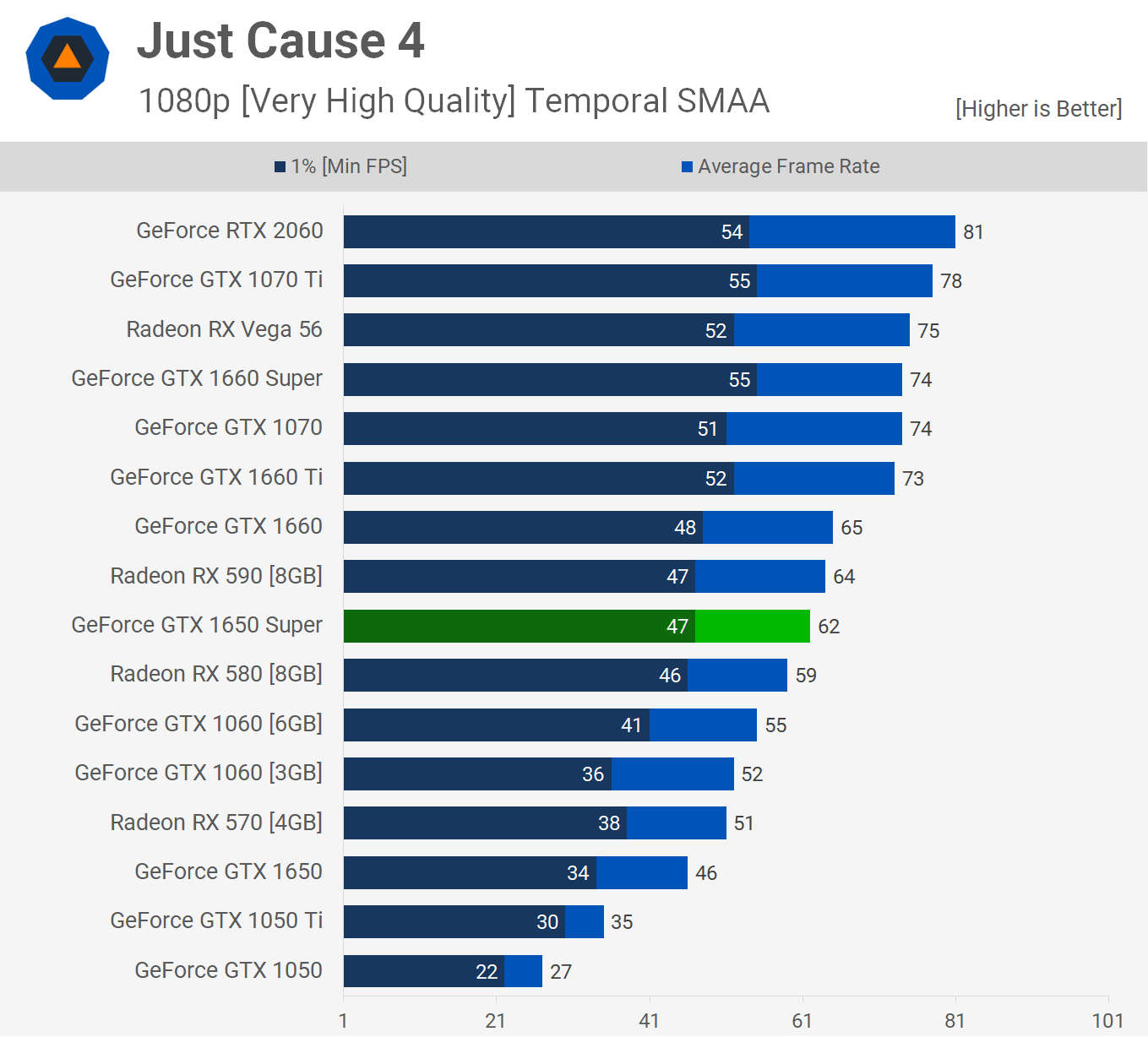
Next up we have Resident Evil 2 and the 1650 Super had no issues delivering smooth playable performance with 83 fps on average. That made it 33% faster than the standard 1650 and 6% faster than the RX 570, though this time it was 12% slower than the GTX 1660.
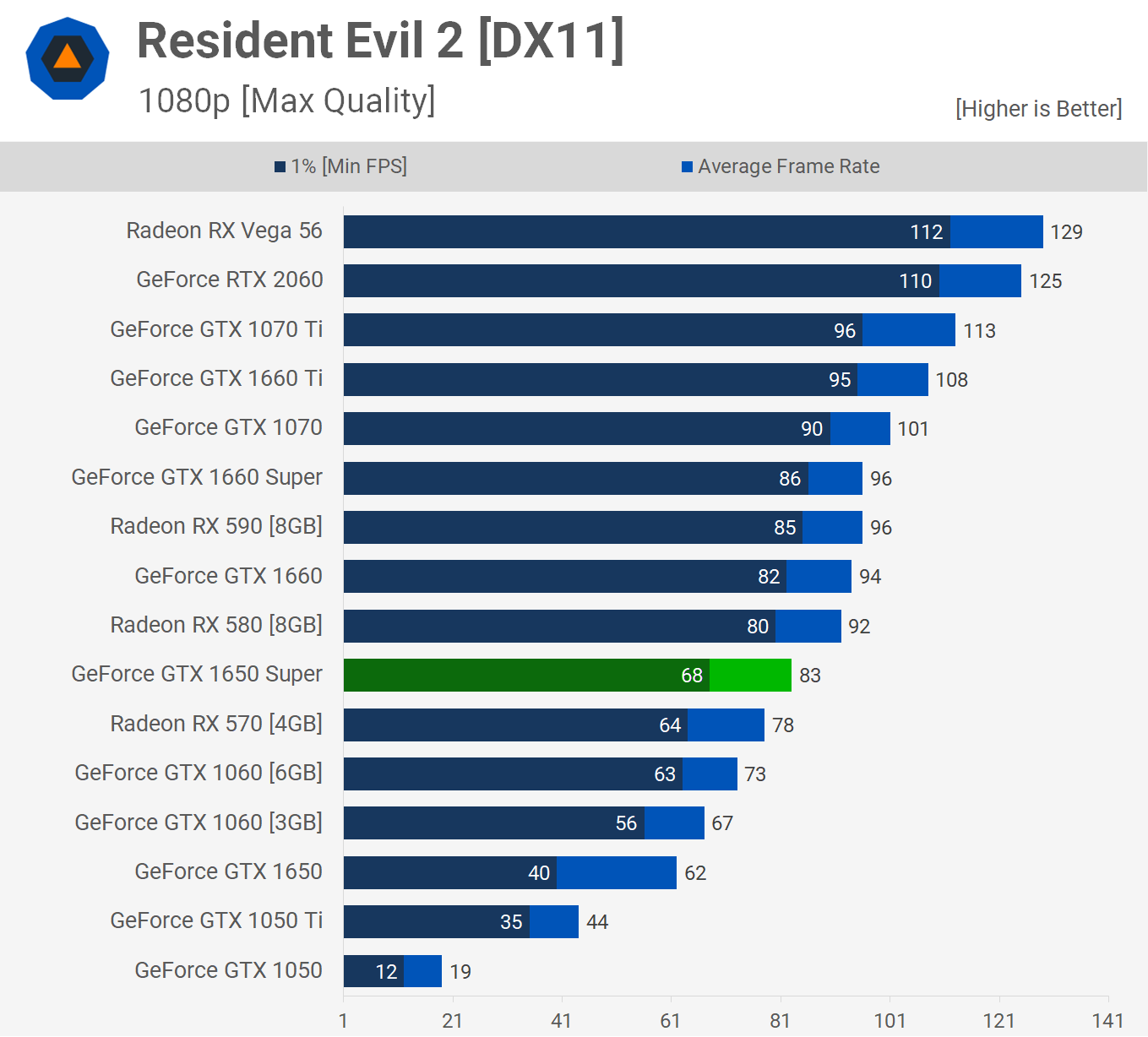
Even with the render scale set to 100%, the 1650 Super had no issue tearing its way through Rainbow Six Siege to deliver 108 fps on average, making it 35% faster than the 1650 and impressively, 10% faster than the RX 580. In fact it even edged out the RX 590.

This time we see a massive 39% performance improvement when going from the 1650 to the 1650 Super and this saw the average frame rate increase from just 51 fps right up to 71 fps. For what amounts to a pretty small difference in price the 1650 Super offers a significantly better gaming experience in this title.
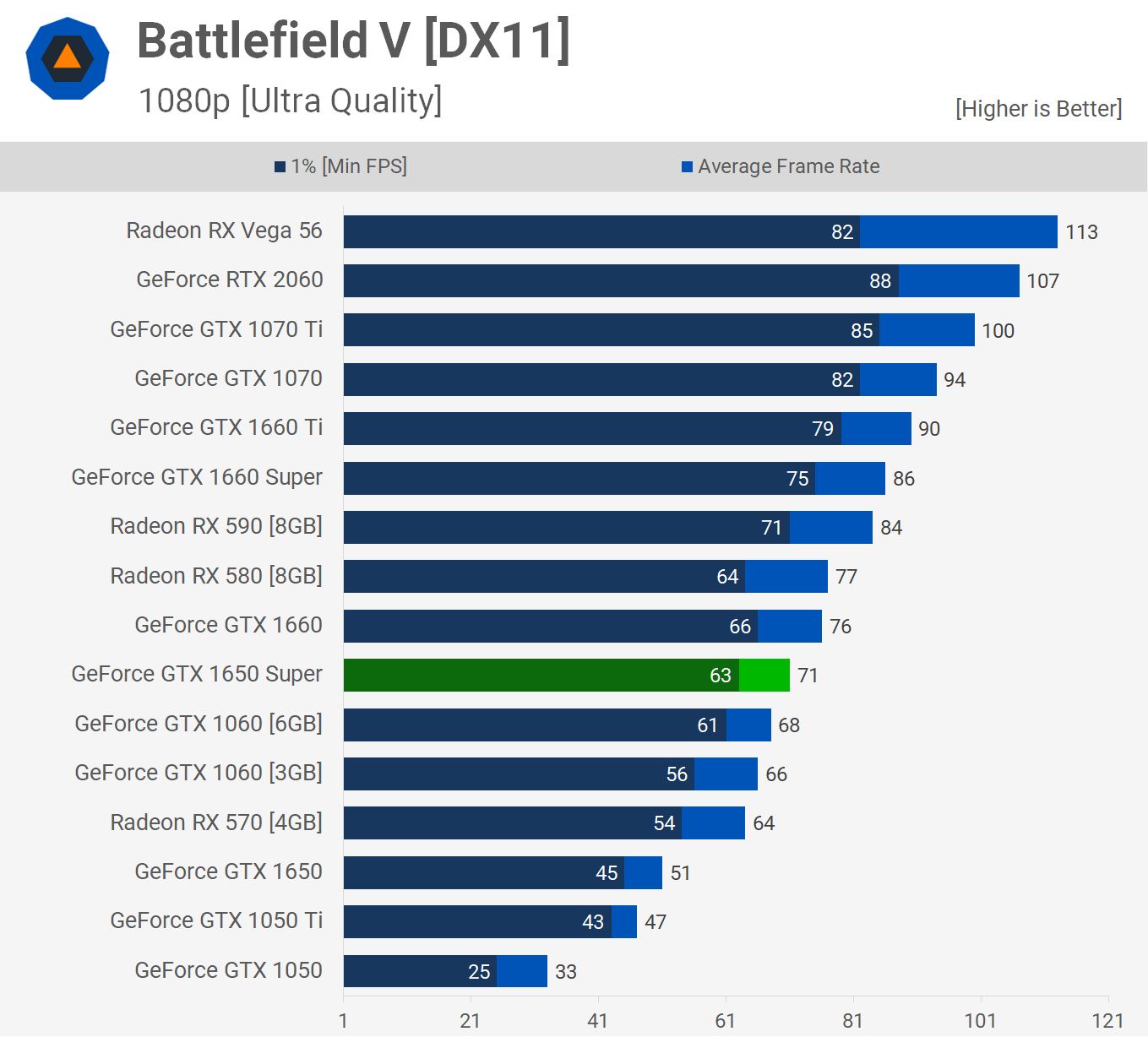
Where as the GTX 1650 struggled in Far Cry New Dawn at 1080p, with an average of just 57 fps and 1% lows below 40 fps, the 1650 Super has no such issue, pumping out almost 80 fps on average making it 37% faster. The 1% low performance was also much better, never dipping below 60 fps.

Next up we have The Division 2 and here the 1650 Super only averaged 57 fps, which put it on par with the RX 570 and just a few frames down on the GTX 1060 series. Despite that it was still 36% faster than the standard 1650, though it did also trail the GTX 1660 by a 17% margin, still overall decent performance at 1080p.
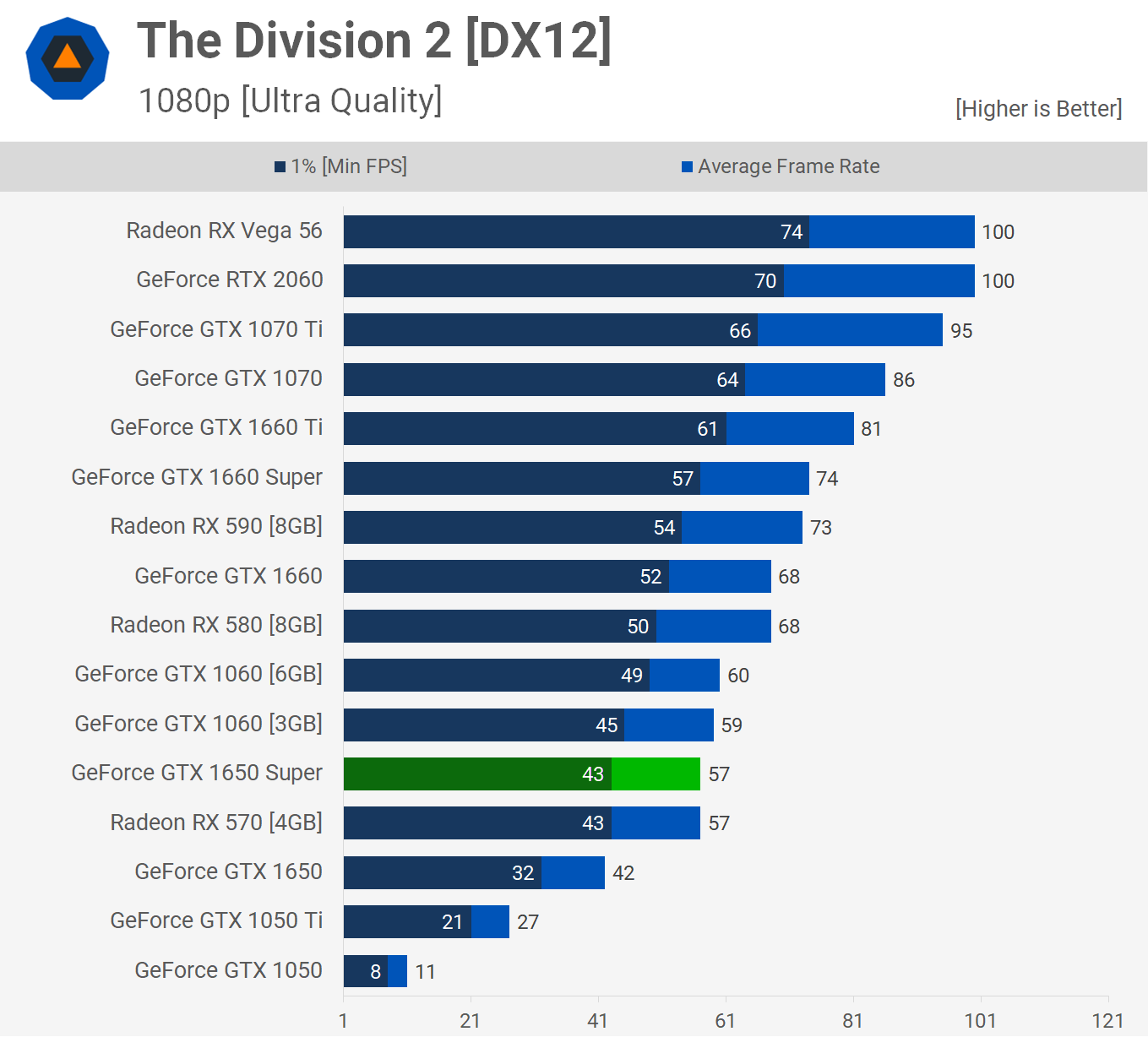
This time we find that the 1650 Super is just 27% faster than the vanilla 1650 and while that's still quite a large margin, it's the smallest margin we've seen yet. Still the Super version did break the 60 fps barrier in our test and that meant it was a few frames faster than the RX 580, so a solid result.
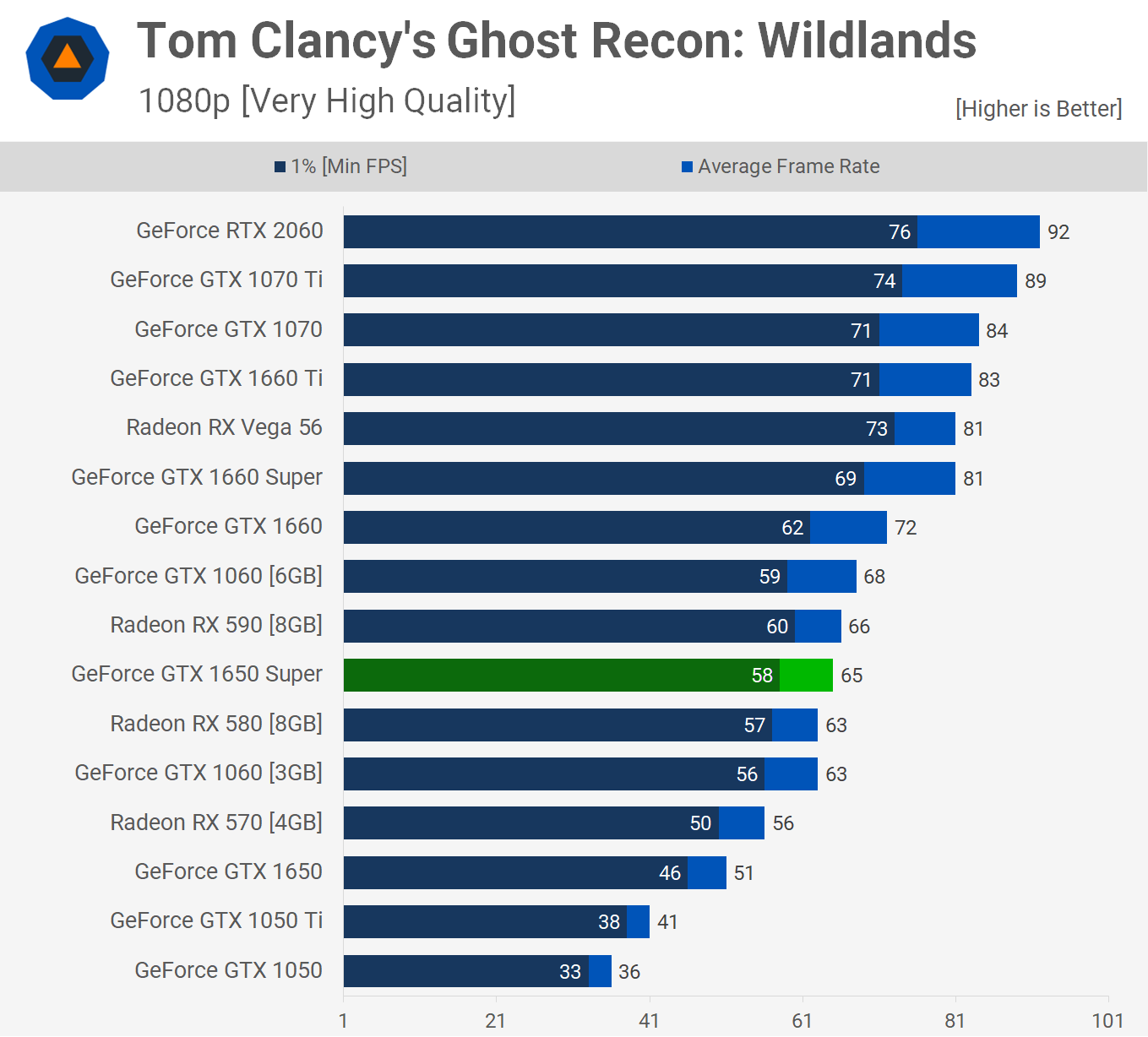
We're back to strong performance gains, this time when testing with Prey. Here the 1650 Super was 38% faster than the standard 1650, pumping out 109 fps on average and this placed it within a few frames of the RX 580, and 13% slower than the GTX 1660.
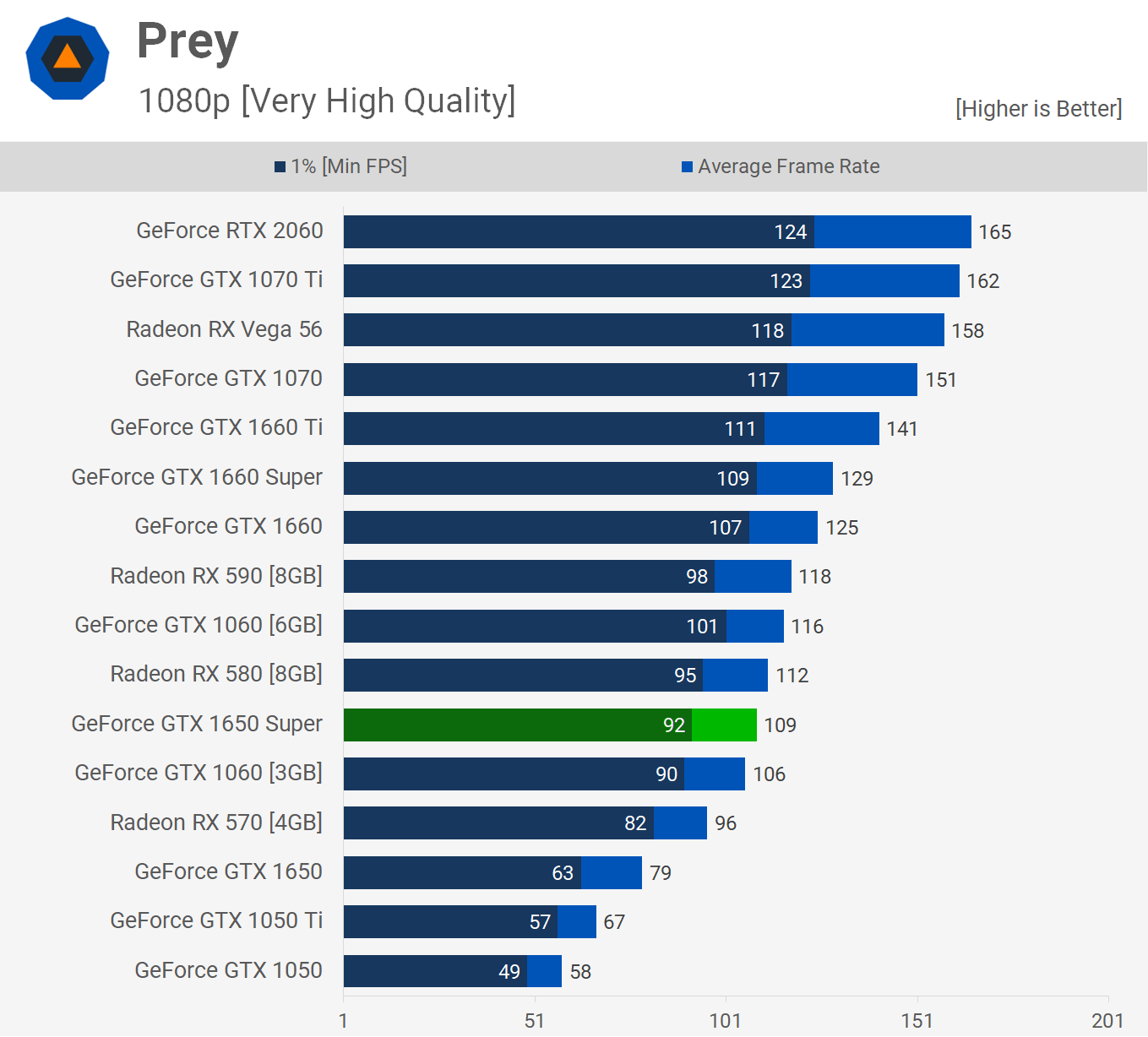
Performance in Star Wars Battlefront II is very impressive, not only is the 1650 Super 41% faster than the GTX 1650, it's also 11% faster than the RX 590 and just 7% slower than the GTX 1660, so a steller result here.

The affordable Radeon GPUs surprisingly still have an advantage in Project Cars 2, here the 1650 Super only averaged 51 fps, making it slower than even the RX 570, and that's despite a 38% performance boost over the standard 1650.
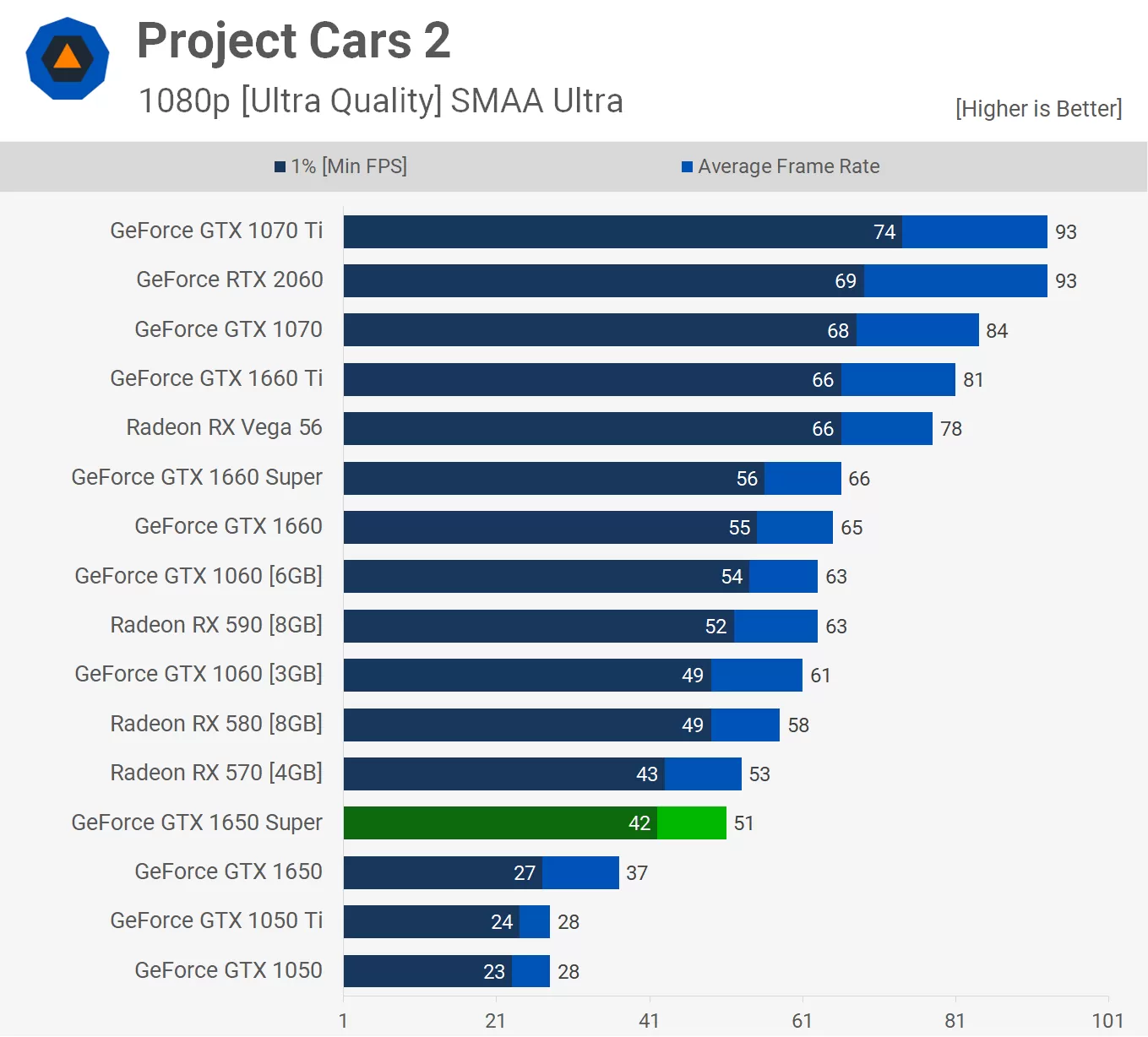
Monster Hunter: World sees the 1650 Super providing a 38% performance boost over the standard 1650 which saw the average frame rate increase from 40 fps up to 55 fps, and again that is a significant improvement that you'll certainly notice.
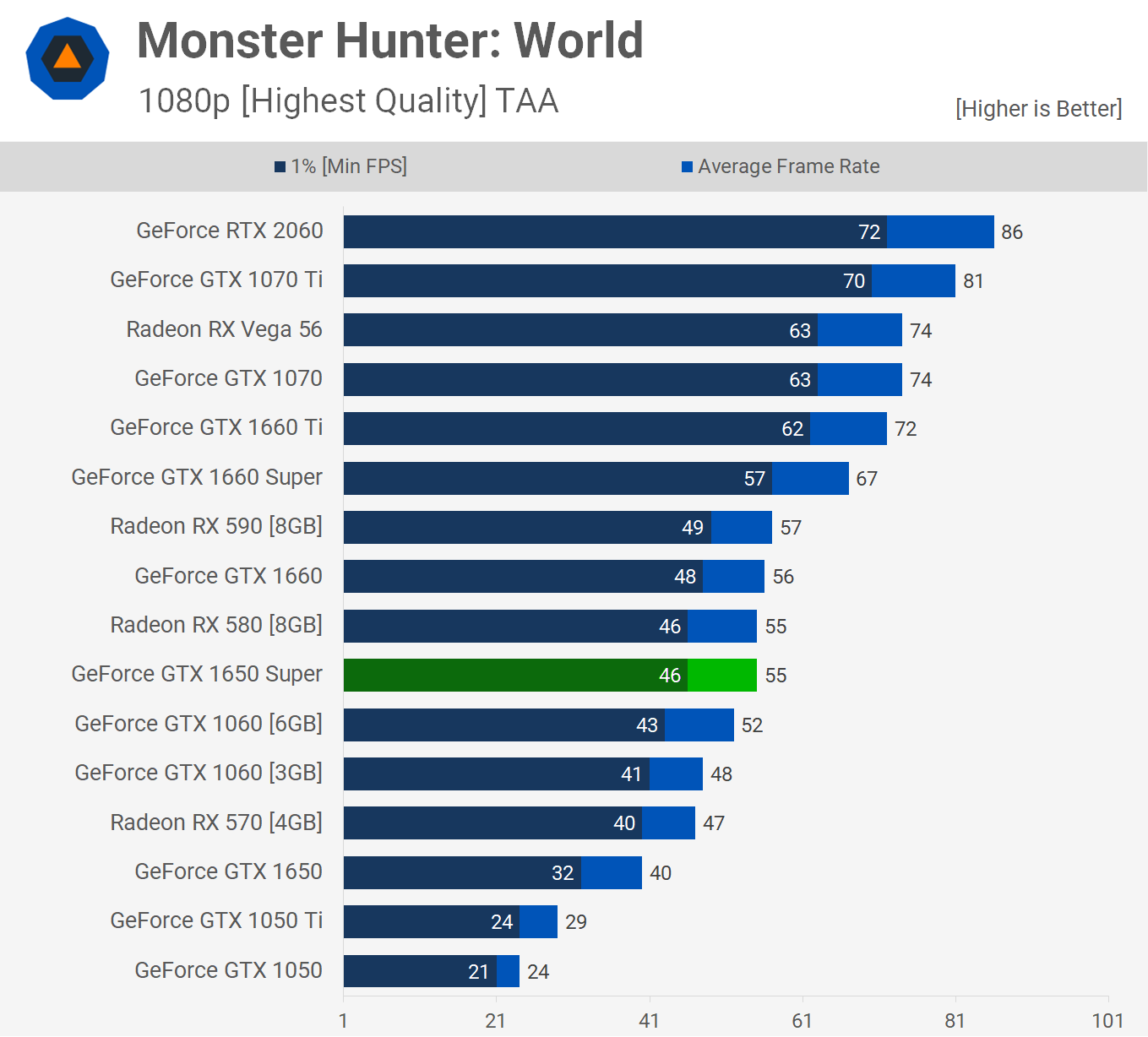
For Honor sees the 1650 Super push the average frame rate up from 62 fps with the 1650 to 79 fps and that's a decent 27% performance bump. It also meant the 1650 Super was a few frames slower than the RX 570 and just a few frames slower than the RX 580.
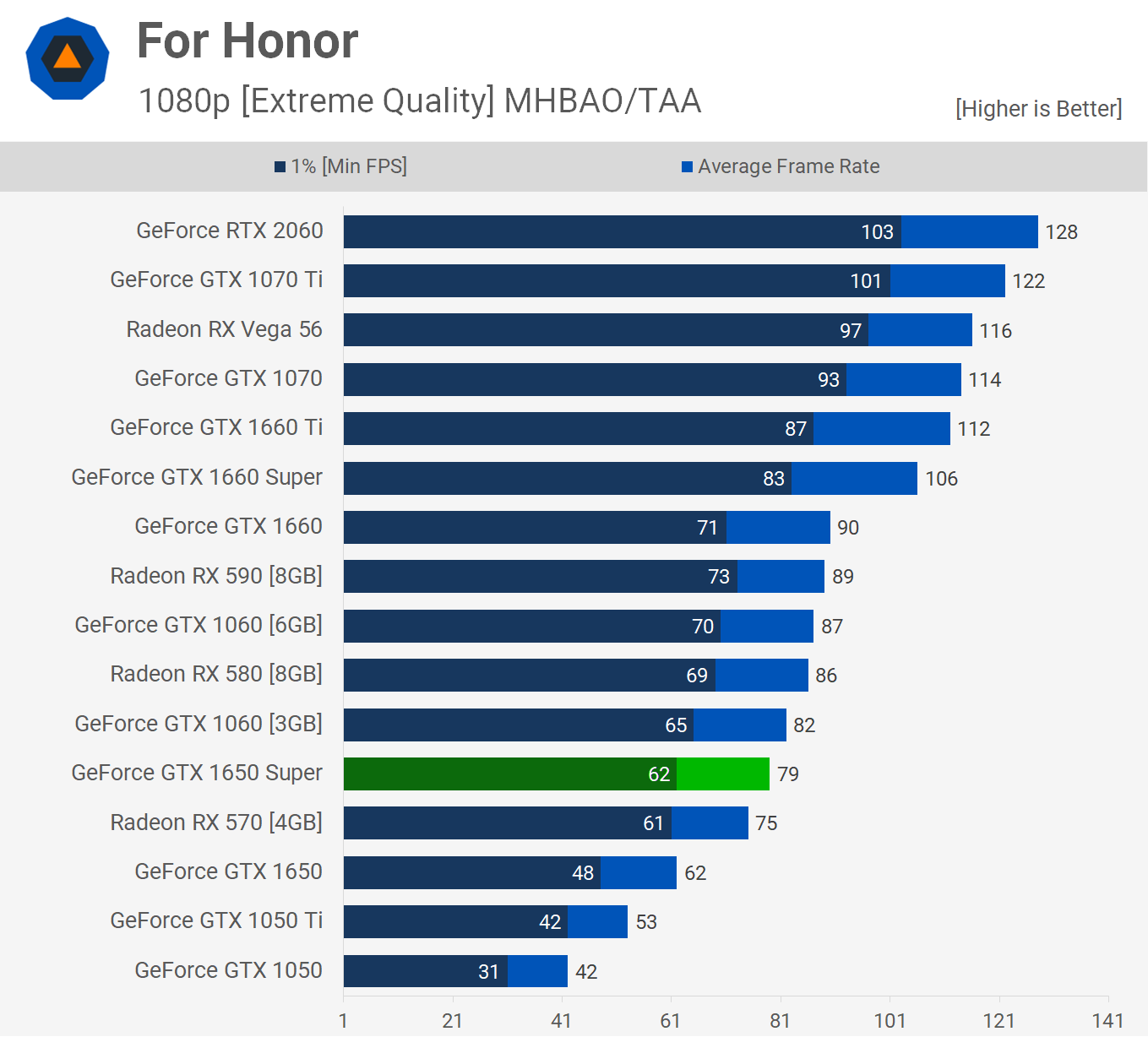
The Witcher 3 Wild Hunt results are interesting, the 1650 Super is 37% faster than the standard 1650 which is pretty standard, given what we've seen so far. However it's also able to match the performance of the standard GTX 1660 in this title, and that's not something we've really seen in the other games already tested.
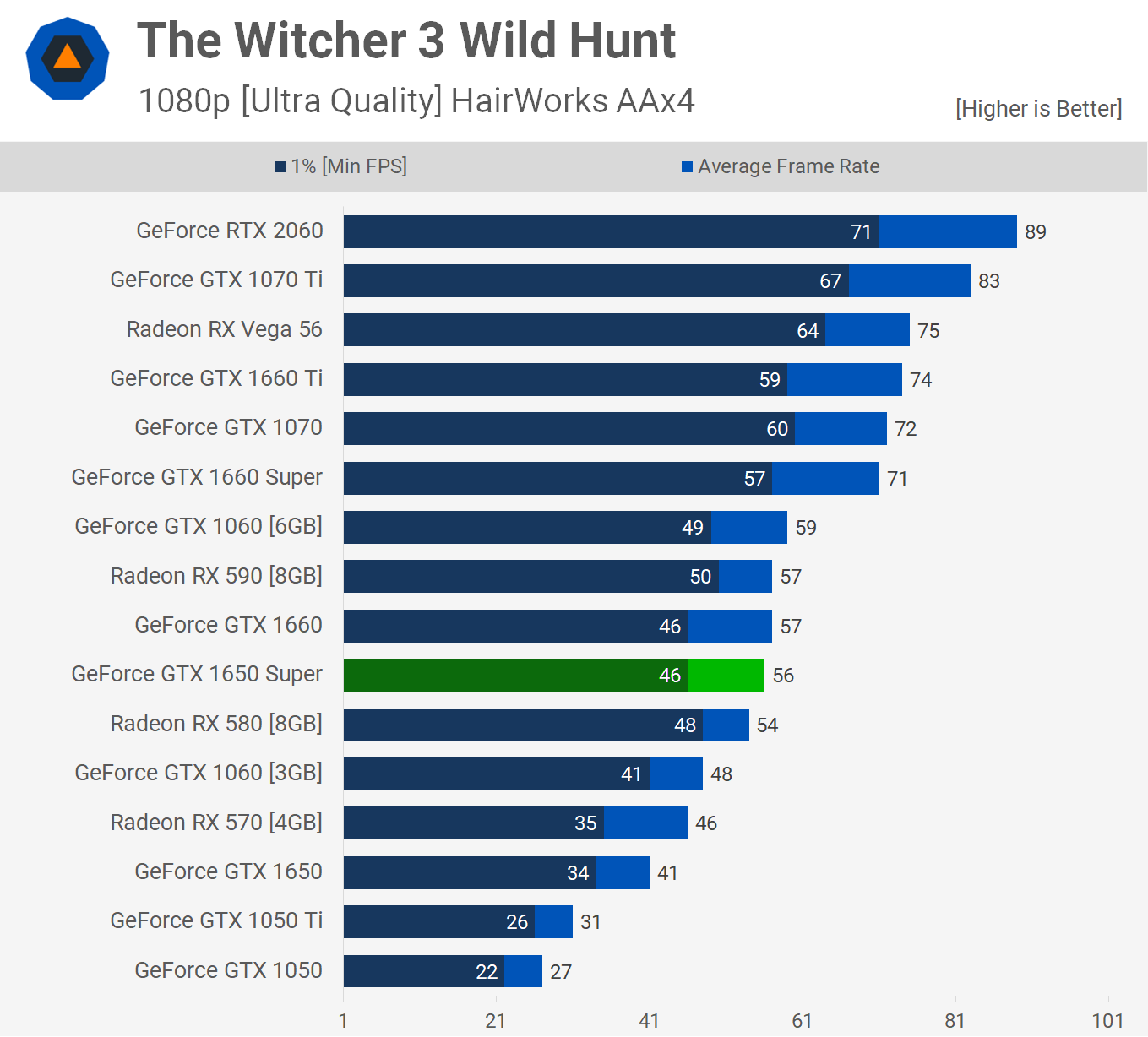
Although the 1650 Super only matched the Radeon RX 570 in Sniper Elite 4, it was still a whopping 43% faster than the standard 1650, taking the average frame rate from 63 fps right up to 90 fps.
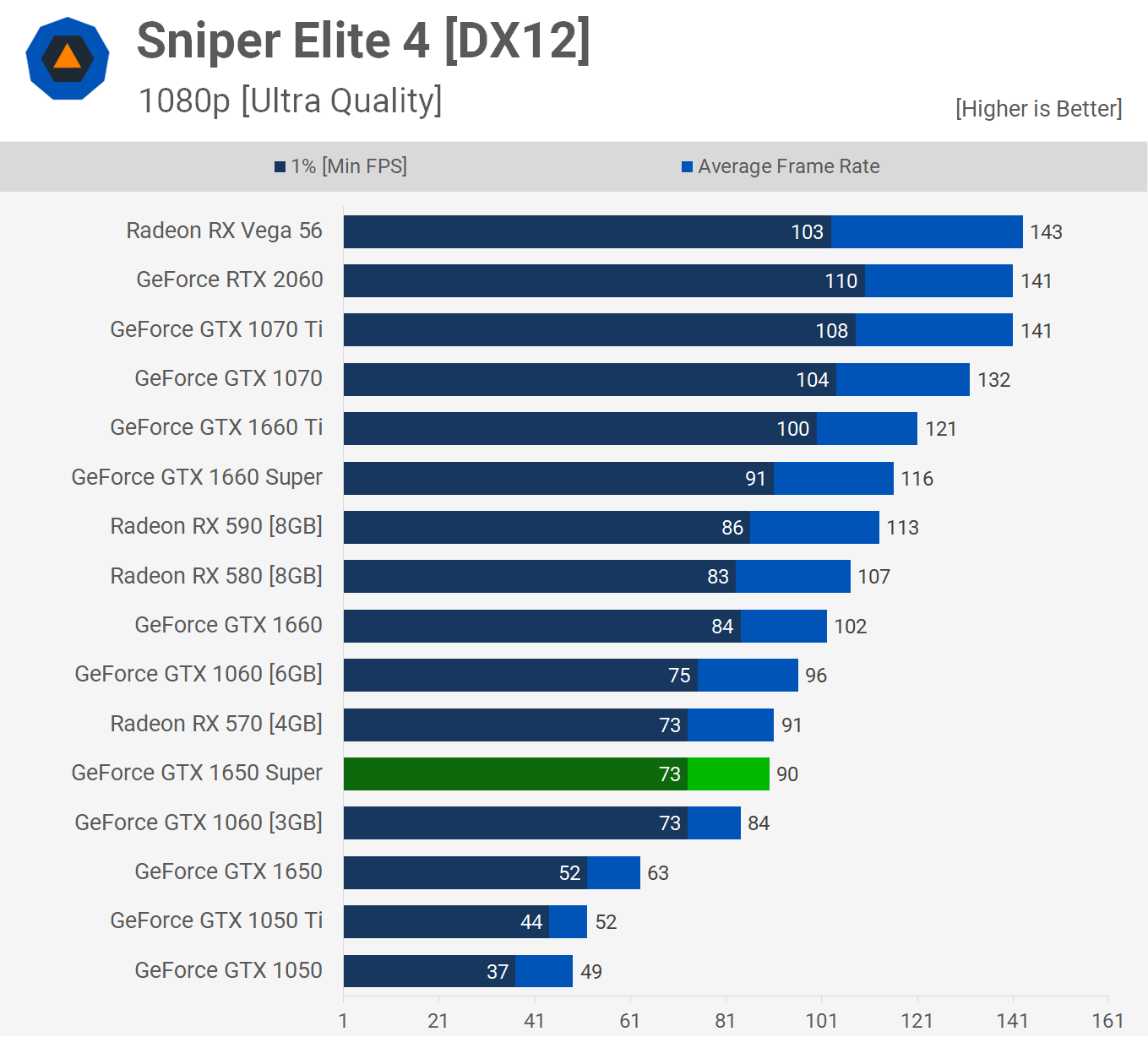
Performance in Kingdom Come Deliverance isn't amazing at 1080p, though relative to the competition it's certainly not bad. Here the 1650 Super was just a few frames down on the RX 580, and 9% slower than the GTX 1660.
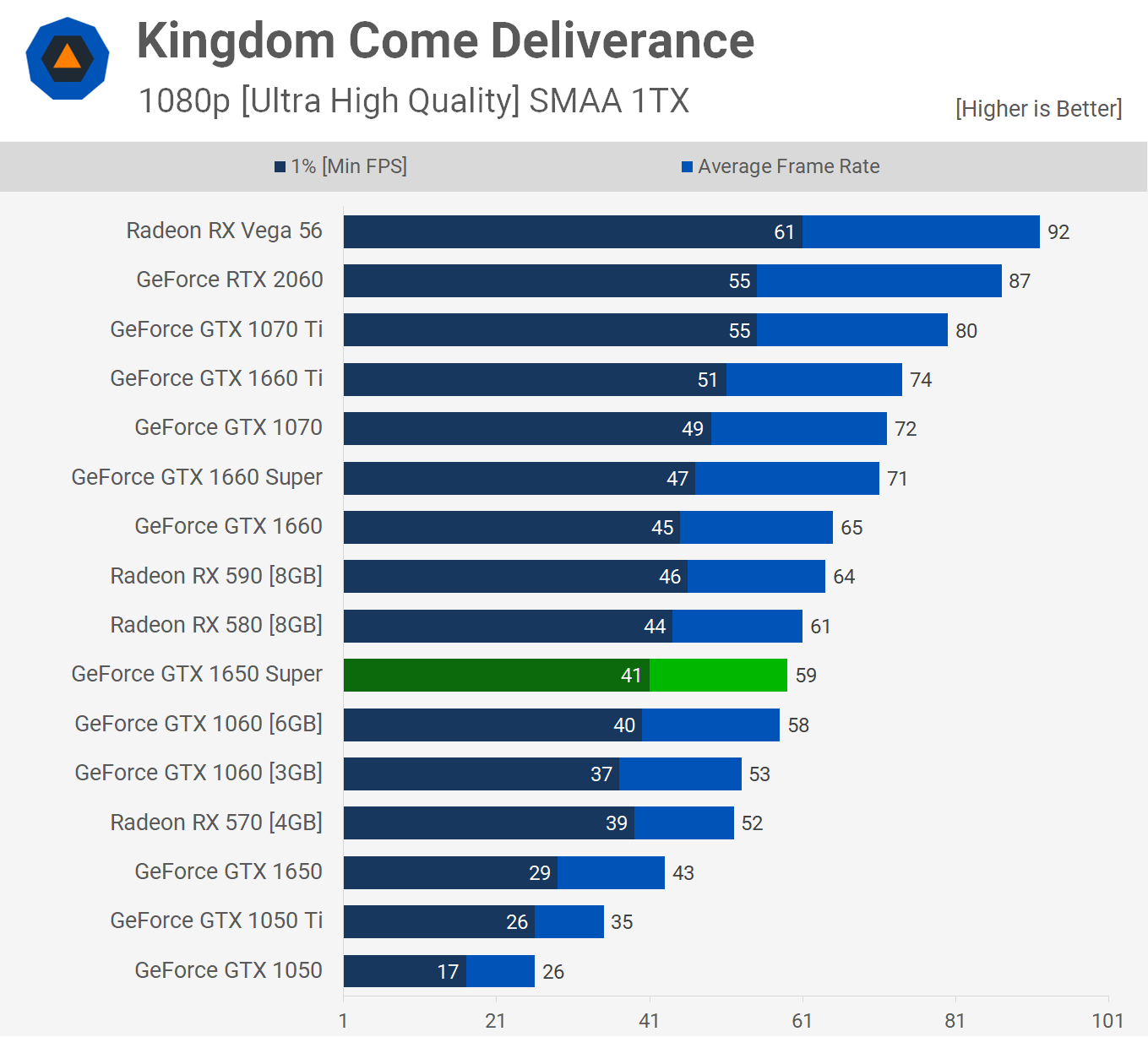
Last up we have Shadow of War and as was the case with The Witcher 3 Wild Hunt, we see that the 1650 Super is able to match the GTX 1660. Oddly though it was just 13% faster than the vanilla GTX 1650 and that's the smallest margin we saw in this testing, so some very unexpected margins in this game.

Power Consumption
Considering that the GTX 1650 Super was often 30 to 40% faster than the standard 1650, a 20% increase in total consumption is very good. It also consumed 16% less power than the GTX 1660 and a whopping 26% less than the RX 580, so in terms of efficiency the 1650 Super is excellent.

Overclocking
A quick look at overclocking performance, a maxed out Gaming X was boosted by 10% in Battlefield V, taking us to 78 fps on average and that made the 1650 Super slightly faster than the RX 580.

Performance in Rainbow Six Siege was boosted by 7% and this allowed the 1650 Super to match the GTX 1070. Pretty amazing stuff for a sub-$200 graphics card.

We also see a healthy 13% performance boost in Shadow of the Tomb Raider. Here the overclocked 1650 Super spat out 68 fps on average, making it 11% slower than the stock GTX 1660.
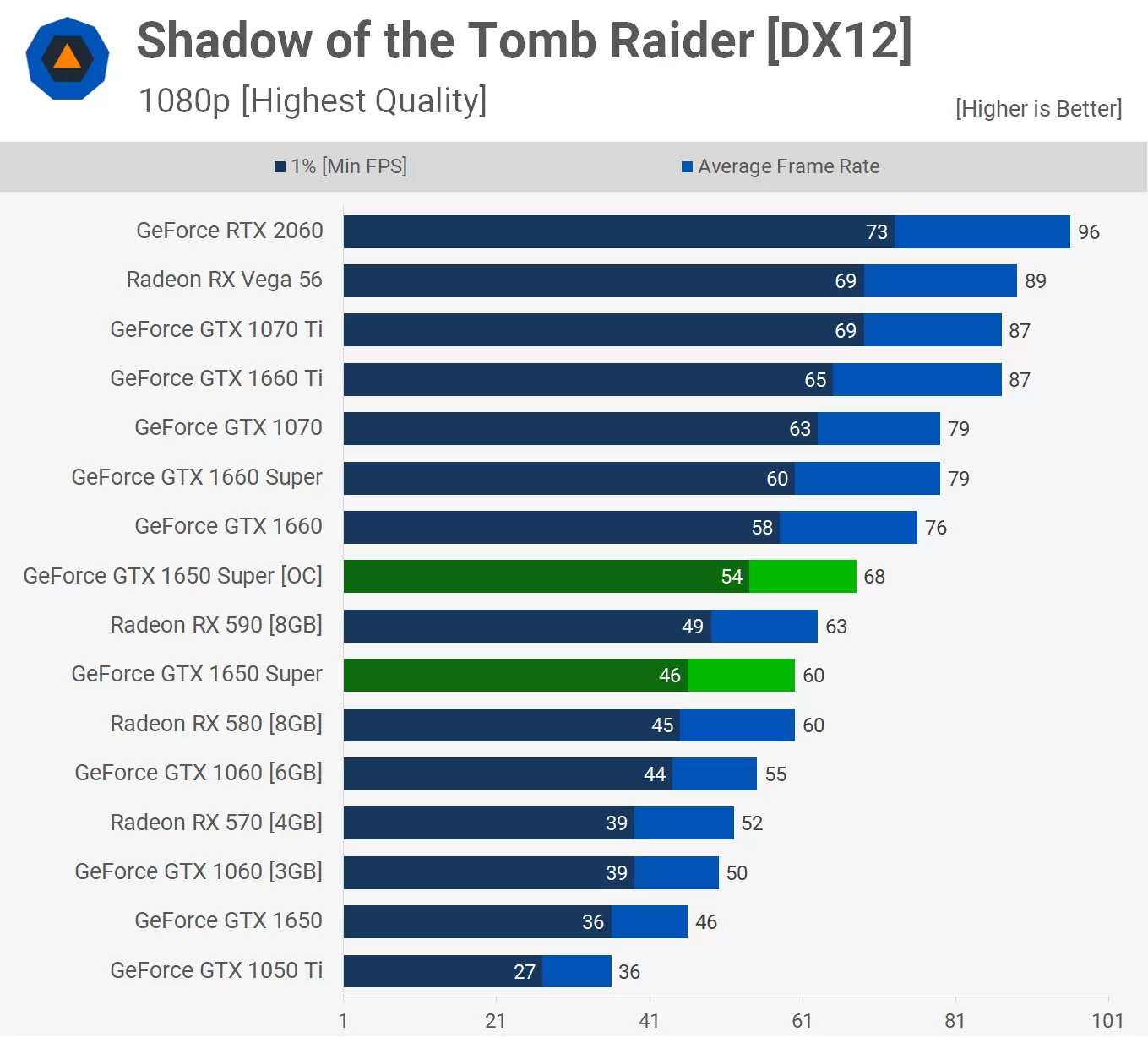
Performance Summary
The 1650 Super looked great across all those games but for a really good idea of how it stacks up let's look at the average frame rates across all 17 games tested at 1080p.
On average the GTX 1650 Super is comparable to the Radeon RX 580 as a single frame separates them. A similar story as we saw with the older GTX 1060 6GB, the 1650 Super is ~2 fps faster, which results in essentially the same performance on average.
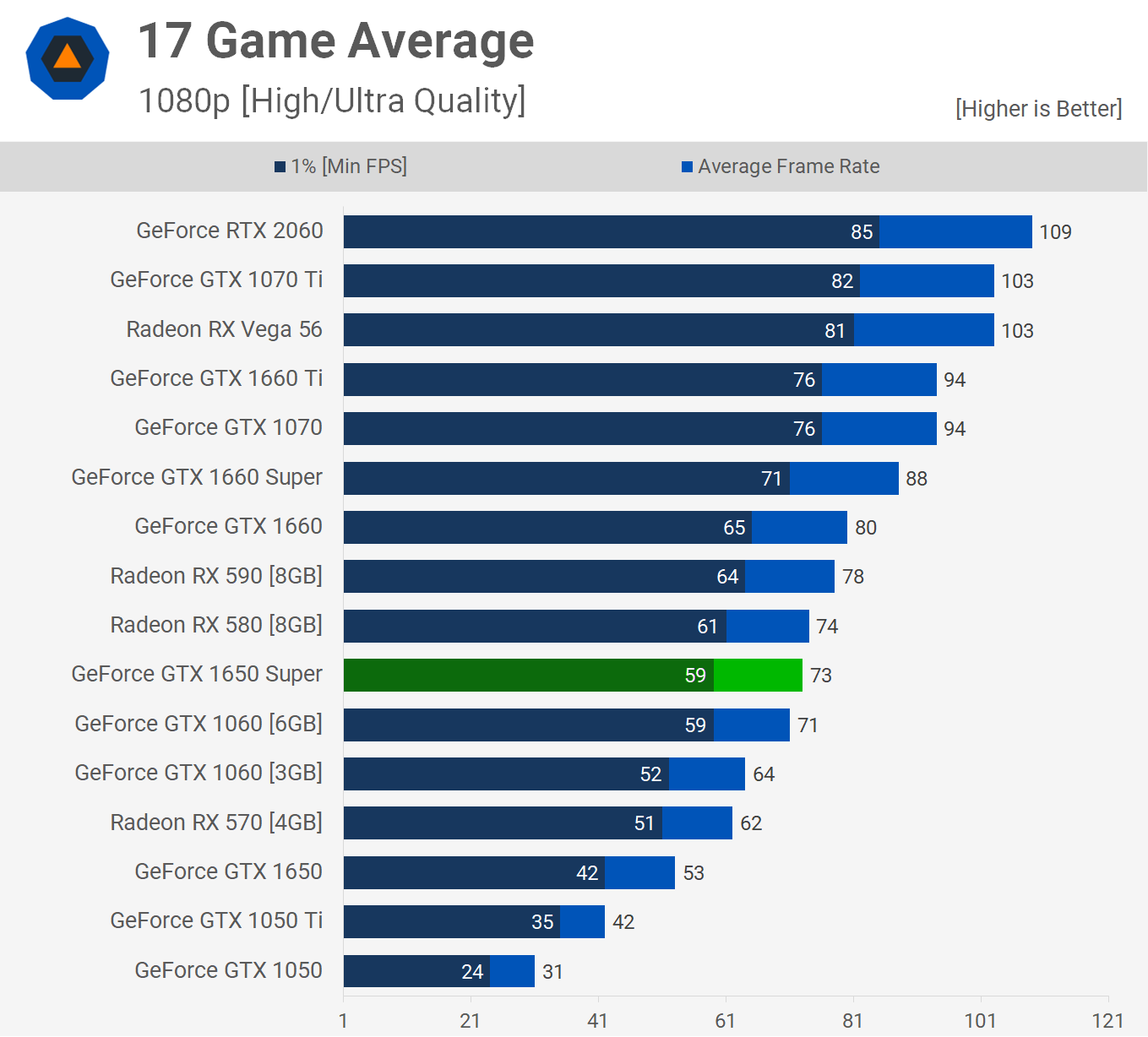
Coming from the original 1650 we're looking at a 38% performance boost on average, while the 1650 Super was just 9% slower than the GTX 1660 and 17% slower than the 1660 Super. All in all, the 1650 Super appears to be in a good place, but let's see how it stacks up in terms of cost per frame...
First please note that Nvidia in their infinite wisdom not only withheld drivers ahead of launch, but also didn't disclose finalized pricing. We didn't know the exact MSRP, but made a pretty good guess based on the information we had. The MSI Gaming X model used for testing in this review will retail for $180. The vanilla GTX 1650 Super cards' MSRP will be ~$160, or just $10 more than the original. Based on that data, here's our chart for cost per frame.

It looks like Nvidia has finally been able to take out the RX 580, undercutting it and delivering better value. This makes the new GTX 1650 Super the best value budget graphics card. While the RX 570 is still very competitive at $130, we feel for the extra $30 the 1650 Super is a better product, it uses less power and because of that most models will run cooler and quieter as a result.
Even at $170 the GTX 1650 Super is still better value than either the RX 580 or RX 590 and given its efficiency we'd say it's worth paying a $10-20 premium for. Nvidia seems to have hit it out of the park with this one.
Excellent Value GPU
Going back to early 2019, we kind of understand why Nvidia wanted to delay information on the original GTX 1650 reviews. It was a pointless product. Half the models featured PCIe power connectors making them utterly pointless and the other half are full height cards. At $150, the GTX 1650 was never a good buy and was never competitive against the Radeon RX 570.
This actually looks to be a really good, really competitive product. But hey, it seems Nvidia doesn't want you to know about it.
Using that same logic with the GTX 1650 Super does not add up. This actually looks to be a really good, really competitive product. But hey, it seems Nvidia doesn't want you to know about it even though it's arguably the most interesting product Nvidia has refreshed this year using the 'Super' moniker.
With the upcoming Radeon RX 5500 release, we'd have expected Nvidia to make as much noise as possible with this product. We estimate the budget Radeon is only a matter of weeks away now. Could that mean the 1650 Super's reign over the entry-level market segment will be short lived? We'll know soon enough.
Count on us picking that battle up again when time comes. Until then, this MSI Gaming X version of the GTX 1650 Super looks great, it runs cool, quiet and offers a little overclocking headroom. Overall, the GeForce GTX 1650 Super seems to deliver on all fronts for less than $200.
Shopping Shortcuts:
- GeForce GTX 1650 Super on Amazon
- GeForce GTX 1660 Super on Amazon
- GeForce GTX 1660 Ti on Amazon
- GeForce GTX 1660 on Amazon
- GeForce RTX 2060 Super on Amazon
- AMD Radeon RX 590 on Amazon
- AMD Radeon RX 580 on Amazon
- AMD Radeon RX 570 on Amazon
- AMD Radeon RX 5700 XT on Amazon
- AMD Radeon RX 5700 on Amazon
- GeForce RTX 2070 Super on Amazon
- AMD Ryzen 5 3600 on Amazon
